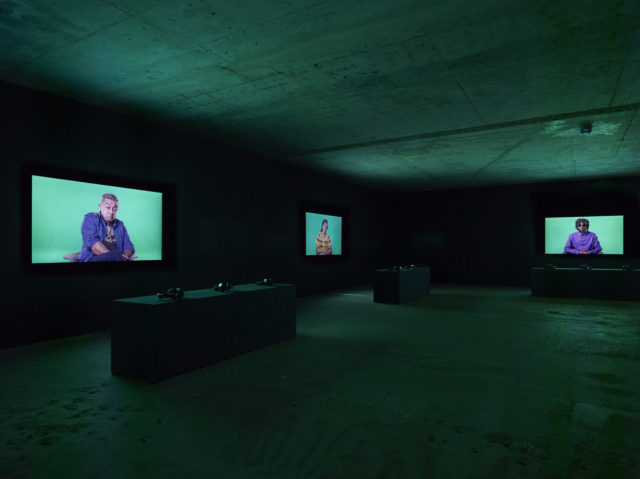A large projection of Candice Breitz‘s Love Story plays on the ground floor of Berlin’s KOW Gallery. Running April 29 to July 30, it shows the familiar faces of two professional film stars, Alec Baldwin and Julianne Moore recounting shocking stories of war, violence, starvation, and abuse written by other people. Without having met the real survivors of these events, they attempt to produce empathy in the viewer by playing convincing characters. The protagonists convey uncomfortable narratives; their identity and the quick cuts between the two scripts confuses their account — it leaves the story noticeably separated from reality.

Born in Johannesburg, Breitz has been chosen to represent South Africa in this year’s Venice Biennale, where Love Story runs through to November 26. Given the prominence of the theme of representation in her work, viewers must ask why the artist (who is not a refugee) should be raising these questions, or if this is another instrumentalization of marginal bodies for a sensationalist production. Recently, a group of activists in Greece kidnapped a sculpture by Roger Bernat during documenta 14’s controversial Athens exhibition in a stand against the exoticization of refugees. Too frequently artists make works about current global conflicts, or identity battles belonging to others, ignoring the context of their own advantageous position in relation to the work’s content. Breitz, in a complex staging of the videos and stories, reflects the individual narratives and their shocking personal anecdotes back towards the receiving audience. Only when exhibited in an art gallery, selected by an artist and recorded professionally do we hear these biographies.
Breitz’ practice has consistently reflected on the creation of identity through cinematic convention. In ‘Working Class Hero‘ (2006), 25 people were filmed singing the John Lennon/Plastic Ono Band song of the same name. By focusing on the fans rather than the icon, Breitz examined how pop and celebrity shapes the culture of their admirers. In Love Story, her own identification is central to the set of films as Breitz again examines how media and cinema affect the lives of everyday people.

At the entrance of KOW, a three-minute video called ‘Profile’ introduces the exhibition on a small screen. The project can be seen as a response to the way in which Breitz perceives her identity within current socio-political norms, and her non-European perspective gives a valuable intersectional approach to identity and crisis. Breitz addresses her own embodiment of her country by organizing a group of emerging South African artists to read her biography, mixed with the other artists’ own phrases. Several sentences read awkwardly as black South Africans read out “this white body cannot represent South Africa,” reflecting a focus on the radical social and racial divides still lingering in a post-apartheid society. In ‘Profile,’ Breitz addresses not only her ability to represent her country but also analyses how her own story can be misrepresented by casting and identity.
In the hands of celebrities Alec Baldwin and Julianne Moore, the stories of refugees are re-interpreted via familiar white faces and standardized North American accents. Baldwin can typically be seen on television impersonating Donald Trump on Saturday Night Live. This illustration of radical free speech is unimaginable to the people he portrays in ‘Love Story’ — some of whom are seeking asylum in the United States.
Breitz thus creates a complex personal interaction between actor and ‘Other’ through extreme contrasts in identity and visibility. The end result might be a nihilistic analysis of contemporary media, but it is nevertheless self-critical of the system that it inhabits and the institutions that remain firmly fixed within the skewed identity politics of empathy. Speaking with Zoé Whitley on the ‘Love Story‘ title, the artist found something in common between all interviewees, which can only be summed up as a passion to continue living freely against all adversity.
Candice Breitz’s ‘Love Story’ is on at Berlin’s KOW Gallery, running April 29 to July 30, and the South African Pavilion of the 57th Venice Biennale, running May 13 to November 26, 2017.













